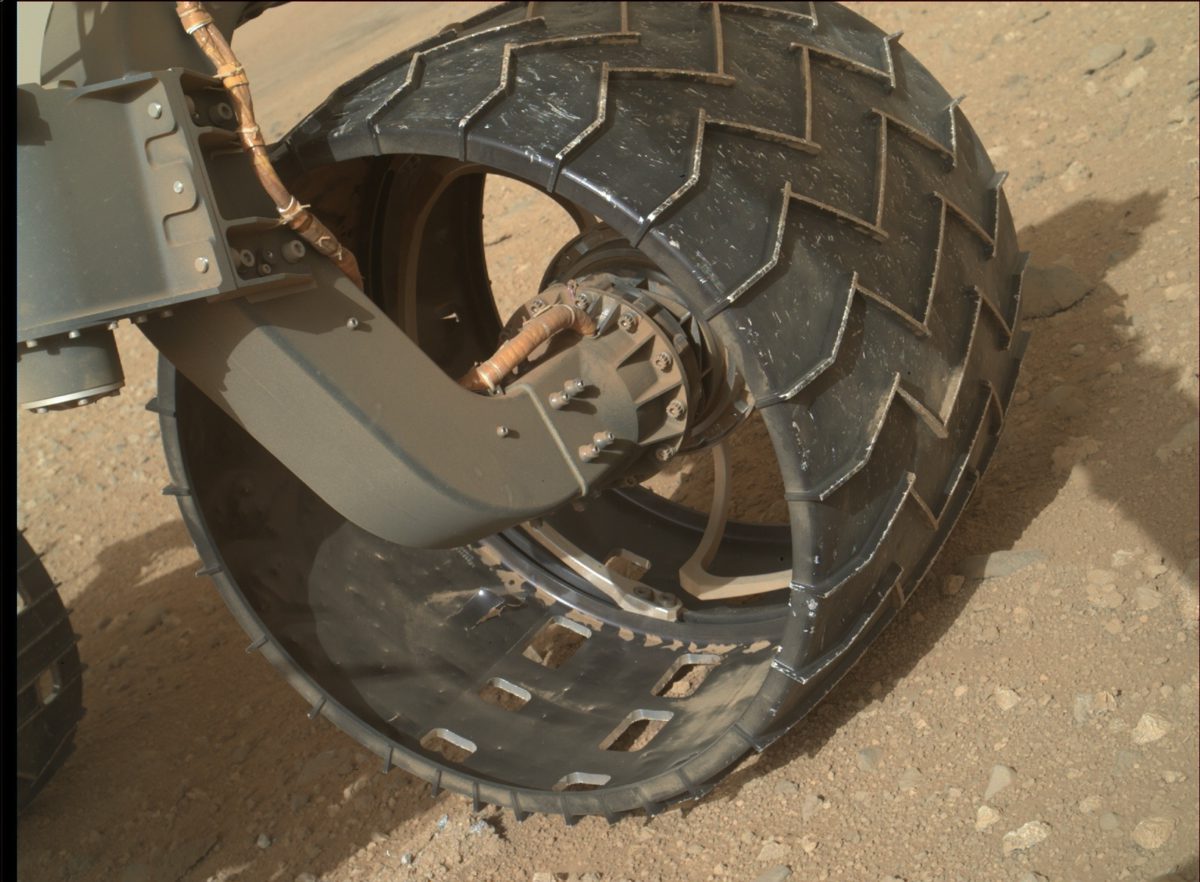Emily Lakdawalla • Oct 02, 2013
Yes, there seems to be a hole in Curiosity's left front wheel, and no, that's not a problem
Some brand-new images just arrived from Curiosity on Mars, and two of the most recent are Mars Hand Lens Imager (MAHLI) images of the wheels. Curiosity uses her arm-mounted camera to check on the status of her undercarriage from time to time. I absolutely love these photos of wheels sitting on the surface of Mars -- there's something both comforting and thrilling about seeing those pieces of human-wrought technology sitting firmly on the dusty ground of another planet.
However, today's images contained two little surprises. In one photo, you can see that the left rear wheel appears to be lifted slightly off the ground -- it's perched on a little rock. More worrisome, though, is this view of the left front wheel, which clearly has a hole in it. You can see Mars right through it. But let me spoil the tension right now: holes in Curiosity's wheels are expected and are absolutely not a problem at all. Don't freak out.

Here's a zoom in on the hole that's been punched into the wheel by some random rock or another:
Now that you've seen the big hole, look closer at the whole wheel and at the sol 411 photo of the other two left wheels and you will discover various other spots where you can see bright Mars in holes punched right through the wheels, which are clearly similar in thickness to soda cans. I can understand why this would cause some consternation among viewers. We spent two billion dollars to put this thing on Mars! Couldn't we have sent it with better wheels? Is this going to endanger the mission?
Let me answer the second question first: no. It's not going to be any kind of problem at all. All the wheels are required to do is to rotate and to grip the ground. The motors in Curiosity's wheels (each one has its own motor) have insanely high torque. I have it on good authority that if Curiosity had square wheels, she would still roll across Mars just fine. They won't ever be square, but they may become oval, and that will be okay, according to official documents from Curiosity engineers. If you took the wheels away and just had those six-spoke titanium spindles she would operate just fine. Round wheels are only really a requirement if you want a vehicle to be able to coast frictionlessly. We never want Curiosity to coast, because then we wouldn't know precisely where she was. Curiosity's top speed is the same as Spirit and Opportunity's -- barely 5 centimeters per second. Most of the time, she grinds along at 1 or 2 centimeters per second. Get up from your computer now and try to walk at 2 centimeters per second. That's not walking. It's shuffling. It's almost standing still. And you don't need round wheels to be able to shuffle; you need to have your feet firmly connected to the ground. Curiosity's wheels could be just about any shape and still be firmly grounded. The wheels are going to be thoroughly battered by the time the mission is over, but they'll still be essentially round and have a lot of raised tread and a lot of grip; she'll be fine.
Okay, now for the first question. Couldn't we have sent Curiosity with better wheels? Sure, we could've. Curiosity was built from scratch; the wheels could've been made any thickness, from any material. But making them heavier and thicker would've added weight without improving her ability to accomplish her mission. And adding weight adds cost -- or even worse, it requires you to remove weight somewhere else on the spacecraft. Spacecraft engineers don't add weight without good reason; they shave excess weight off anywhere they can, so they can use that precious mass to make some other part better that needs to be better.
It seems really wrong for there to be holes in Curiosity's wheels. But it was actually the right thing to do, to allow that to happen. So don't freak out. Enjoy those holes as badges of honor, marks of the miles traversed already.
Go Curiosity!
The Time is Now.
As a Planetary Defender, you’re part of our mission to decrease the risk of Earth being hit by an asteroid or comet.
Donate Today

 Explore Worlds
Explore Worlds Find Life
Find Life Defend Earth
Defend Earth


